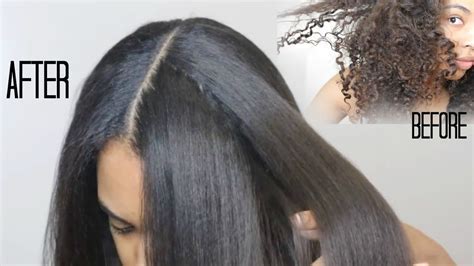Are you longing for silky, manageable hair, free from the persistent tangles and frizz that accompanies your natural curls? Look no further than curly hair relaxers, a game-changing solution that promises to tame your unruly tresses. Immerse yourself in this comprehensive guide to discover everything you need to know about this hair-transforming treatment, from its types and benefits to the step-by-step process and essential safety considerations.

Types of Curly Hair Relaxers
Relaxers come in various formulations, each catering to specific hair types and desired results. Understanding the different types will help you make an informed choice:
-
Sodium Hydroxide (Lye) Relaxers: These are the strongest type of relaxers, effectively breaking down the bonds in your hair to achieve maximum straightening. They are ideal for coarse, thick hair.
-
Calcium Hydroxide (No-Lye) Relaxers: Gentler than lye relaxers, these use calcium hydroxide to gradually relax the hair. They are suitable for medium to fine hair and those with sensitive scalps.
-
Guanidine Hydroxide (No-Lye) Relaxers: These use guanidine hydroxide to relax the hair without the harshness of lye. They are often used on fine or damaged hair that requires a gentler approach.
Benefits of Curly Hair Relaxers
Embrace the transformative power of curly hair relaxers and witness firsthand their myriad benefits:
-
Effortless Detangling: Bid farewell to persistent tangles and knots. Relaxed hair glides effortlessly through brushes, making styling a breeze.
-
Reduced Frizz: Tame the frizz and flyaways that plague curly hair. Relaxers smoothen the hair shaft, minimizing frizz and creating a sleek, polished look.
-
Enhanced Manageability: Experience a newfound level of control over your hair. Relaxed tresses are more manageable, allowing for effortless styling and versatile hairstyles.
-
Increased Versatility: Expand your styling options with relaxed hair. Embrace a range of hairstyles, from sleek ponytails to voluminous buns, without the limitations of natural curls.
Safety Considerations
While curly hair relaxers offer alluring benefits, it is imperative to prioritize safety and minimize potential risks:
-
Scalp Irritation: Some people may experience scalp irritation or allergic reactions due to the chemicals in relaxers. Perform a patch test before applying it to your entire head to rule out any allergies.
-
Hair Damage: Overuse or improper application of relaxers can lead to hair damage, including breakage, dryness, and thinning. Follow the instructions carefully and avoid excessive or frequent use.
-
Chemical Burns: Relaxers contain strong chemicals that can cause chemical burns if they come into contact with your skin. Protect your scalp with a barrier cream and follow the application instructions diligently.
Step-by-Step Guide to Relaxing Curly Hair
Transforming your curly hair into silky, manageable tresses involves a meticulous step-by-step process:
-
Section Your Hair: Divide your hair into four equal sections to ensure even application.
-
Apply Relaxer: Generously apply the relaxer to each section, starting from the roots and working your way to the tips. Use a brush or comb to distribute the relaxer evenly.
-
Processing Time: Relaxers typically require a processing time of 15-30 minutes, depending on the strength of the relaxer and your hair type. Follow the instructions on the relaxer package carefully.
-
Neutralizing: After the processing time, neutralize the relaxer using a neutralizing shampoo. This step stops the chemical process and restores your hair’s pH balance.
-
Conditioning: Deep condition your newly relaxed hair to replenish moisture and prevent dryness.
Tips and Tricks for Perfect Results
-
Test a Strand: Perform a strand test on a small section of your hair before applying it to your entire head to determine the optimal processing time and ensure your hair can tolerate the relaxer.
-
Protect Your Scalp: Apply a barrier cream around your hairline and ears to protect your skin from chemical burns.
-
Don’t Overlap: Avoid applying relaxer to areas that have already been treated to prevent over-processing and damage.
-
Follow Instructions: Read the relaxer instructions thoroughly and follow them meticulously to achieve the desired results and minimize risks.
-
Moisturize Regularly: Relaxed hair tends to be drier than natural hair. Maintain a regular moisturizing routine to keep your hair healthy and hydrated.
Empowering Women with Curly Hair
Curly hair relaxers have revolutionized the haircare landscape, empowering women with curly hair to embrace their desired hairstyles. According to the National Hairdressers Association, over half of women with curly hair have used a relaxer at some point in their lives.
Future of Curly Hair Relaxers
The future of curly hair relaxers holds exciting possibilities. Research and innovation are focused on developing gentler formulations and advanced techniques that minimize the potential risks associated with relaxers.
Tables for Enhanced Understanding
| Relaxer Type | Benefits | Cautions |
|---|---|---|
| Sodium Hydroxide (Lye) | Maximum straightening | Strongest formula, potential for scalp irritation |
| Calcium Hydroxide (No-Lye) | Gentle on hair, suitable for sensitive scalps | Requires longer processing time |
| Guanidine Hydroxide (No-Lye) | Gentlest formula, ideal for fine and damaged hair | May not achieve as much straightening as other types |
| Processing Time | Hair Type |
|---|---|
| 15-20 minutes | Fine, damaged hair |
| 20-25 minutes | Medium-textured hair |
| 25-30 minutes | Coarse, thick hair |
| Frequency of Use | Hair Health |
|---|---|
| Every 6-8 weeks | Healthy hair |
| Every 8-12 weeks | Dry or damaged hair |
| Avoid excessive use | May lead to hair breakage and thinning |
| Tips for Healthy Relaxed Hair |
|---|
| Moisturize regularly |
| Use deep conditioners |
| Trim split ends regularly |
| Protect from heat styling |
| Avoid over-processing |
